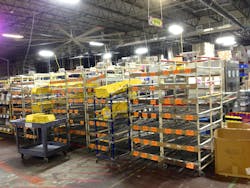Getting Holiday Gifts through Lean: Zingerman's Mail Order
There is nothing particularly exotic about a mail order company filling boxes and mailing them out. But when you are a volume mail order house the difference between the mundane and the exceptional takes a complete change in mindset.
Zingerman's started as a deli with hand-selected exotic foods in downtown Ann Arbor, Mich. The owners are humanists who believe in treating all employees well with open-book financing and benefits and profit sharing usually reserved for managers. They also are passionate about customer service, even publishing books and giving seminars for fees on how to build a great customer-focused business. Members of the Zingerman’s family can suggest businesses, develop a business plan and become co-owners, though once a single business is created it cannot be reproduced or franchised. Each business is unique with a unique culture.
Zingerman’s mail order started in this way, taking advantage of all the Ann Arbor alumni who moved to other parts of the United States and craved their favorite Zingerman’s foods. The business was so successful that sales grew annually and within a few years they outgrew their warehouse and had to move, and then move again, and then move again. Most of their sales occurred in a two-week period before Christmas so they had to hire almost ten times as many seasonal workers as they had during the rest of the year.
Between these newbies to the business and the sudden rash of orders, life was chaos. It seemed to take 50 weeks to recover from the two-week tsunami of orders. Stuff was everyplace in big batches. Gift boxes were made up all night and placed wherever there was a space.
After about nine years of working with one of my former doctoral students, Eduardo Lander, they now look more like a well organized Toyota assembly plant than a chaotic business of putting boxes of goods wherever there is space and then going on a treasure hunt to find them. A moving assembly line is based on the lean concept of Takt.
When I visited this year during the Christmas rush, they were operating comfortably at a pace of a customer order being filled every nine seconds. Pickers have zones and place the goods in a container on a conveyor which gets filled as it moves down the line.
Items are added, gift boxes are built to order, every order is checked by a person with a scanner, and the goods are put in shipping boxes.
The conveyor extends to a UPS truck which is loaded with the UPS driver waiting to take off. When one is full they open the door to a second truck waiting to be filled, and another empty truck arrives in the first spot.
Visual management, standard work, chiefs who are year-round employees acting as group leaders, kanban, visible performance metrics, andon and virtually every other lean tool in the book is present and vital to the flow of orders to customers. And they have even spread this to the call center and sales. Since the lean journey began they have not moved from this warehouse and in 2013 when they were prepared to move to a larger facility Eduardo implored them to re-layout the building to get another three to five years out of it. They did and it is working even better.
One manager keeps pinching herself and asking, “What have we missed? Why is this crazy sales period going so smoothly? Profits are displayed on walls and are going through the roof, which shows up as profit sharing for year-long employees. Happy Holidays and thank you lean!”
________________________________________
Liker Leadership Institute (LLI) offers an innovative way to learn the secrets of lean leadership through an online education model that is itself lean, and extends that lean education far beyond the course materials. Learn more about LLI's green belt and yellow belt courses in "The Toyota Way to Lean Leadership" and "Principles of Lean Thinking" at the IndustryWeek Store.







